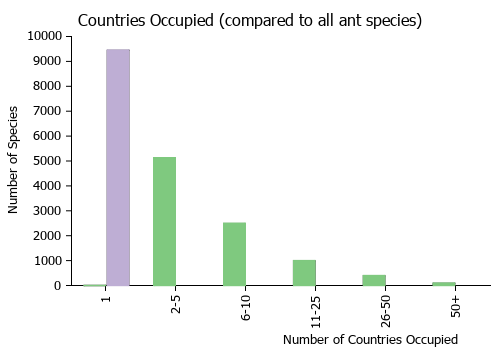Monomorium speculum
| Monomorium speculum | |
|---|---|

| |
| Scientific classification | |
| Kingdom: | Animalia |
| Phylum: | Arthropoda |
| Class: | Insecta |
| Order: | Hymenoptera |
| Family: | Formicidae |
| Subfamily: | Myrmicinae |
| Tribe: | Solenopsidini |
| Genus: | Monomorium |
| Species: | M. speculum |
| Binomial name | |
| Monomorium speculum Sparks, 2015 | |
Colonies of this species were found in a dry lake bed in central western Australian where workers were observed bearing minute gastropod shells into their nest.
Identification
Sparks et al. (2015) - A member of the M. rothsteini species group. A small, glossy dark brown species with large eyes and a slightly concave to sinuous clypeus. The mesonotum is without sculpture except in the posterior region, the propodeal dorsolateral angles clearly form an obtuse angle or are rounded and the petiole node is narrow.
This species cannot be separated from Monomorium subapterum using morphology alone. Evidence for its separation from M. subapterum comes from a species delimitation study undertaken by (Sparks et al. 2014).
Keys including this Species
Distribution
This species range covers a large area of southern inland Western Australia.
Latitudinal Distribution Pattern
Latitudinal Range: -26.5949° to -31.1814°.
| North Temperate |
North Subtropical |
Tropical | South Subtropical |
South Temperate |
- Source: AntMaps
Distribution based on Regional Taxon Lists
Australasian Region: Australia (type locality).
Distribution based on AntMaps
Distribution based on AntWeb specimens
Check data from AntWeb
Countries Occupied
| Number of countries occupied by this species based on AntWiki Regional Taxon Lists. In general, fewer countries occupied indicates a narrower range, while more countries indicates a more widespread species. |

|
Estimated Abundance
| Relative abundance based on number of AntMaps records per species (this species within the purple bar). Fewer records (to the left) indicates a less abundant/encountered species while more records (to the right) indicates more abundant/encountered species. |

|
Biology
Genetics
COI sequences. Genbank accession numbers for this species are KC572983, KC572985, KC572986, KC572992 and KC572997.
Castes
Nomenclature
The following information is derived from Barry Bolton's Online Catalogue of the Ants of the World.
- speculum. Monomorium speculum Sparks, in Sparks et al. 2014: 518, figs. 7g-i, 11f (w.) AUSTRALIA (Western Australia).
- Type-material: holotype worker, 51 paratype workers.
- Type-locality: holotype Australia: Western Australia, Meekatharra, -26.5949, 118.4936, 19.x.2009, KSS193 (K.S. Sparks & C. Petit); paratypes: 20 workers with same data, 20 workers Western Australia, Lake Annean, 40 km. S Meekatharra, -26.8879, 118.2850, 20.x.2009, KSS198 (K.S. Sparks & C. Petit), 6 workers as last but KSS199, 5 workers Western Australia, Niagara Dam, nr Kookynie, -29.4052, 121.4293, 22.x.2009, KSS218 (K.S. Sparks & C. Petit).
- Type-depositories: WAMP (holotype); MHNG, NHMB, SAMA, WAMP (paratypes).
- Distribution: Australia.
Unless otherwise noted the text for the remainder of this section is reported from the publication that includes the original description.
Description
Worker
(n=9). HW 0.62–0.94, HL 0.68–0.98, EL 0.16–0.2, PMH 0.23–0.35, PH 0.21–0.29, PNH 0.14–0.19, LHW 0.39–0.57, EW 0.11–0.14, PML 0.43–0.60, ML 0.7–0.98, PL 0.31–0.43, PNWdv 0.16–0.21.
Small species with a small, rectangular head; posterior cephalic margin shallowly depressed to broadly v-shaped. Anterodorsal margin of the clypeus concave to sinuous with smooth frontolateral carinae forming ridges that do not extend anteriorly beyond anteroventral clypeal margin; anteroventral margin with or without a median projection. Sculpture on frons limited to a few strigae only present on antennal lobes; coarse lateral cephalic strigae reaching or not reach anterior eye margin. Eyes large, EW > 0.23 x LHW, 12 ommatidia in longest vertical axis, 10 in longest horizontal axis.
Mesonotum without sculpture except for posterior region with a few strigulae extending anteriorly from metanotal groove. Mesopleuron and propodeum alveolate with strigae extending over metapleural gland bulla and reaching metanotal groove. Propodeum in lateral view with dorsolateral angles clearly forming an obtuse angle; dorsal surface with anterior transverse carina absent in a majority of specimens, when present then weakly so; transverse and longitudinal strigae absent, longitudinal depression also absent, dorsolateral angles rounded. Petiole node width when viewed from above less than 2 x eye width; oval shaped in posterior view, when viewed laterally with anterior and posterior faces strongly converging to a narrowly rounded dorsum, posterior surface of petiole node without sculpture, smooth and shining. T1 finely imbricate, covering at least anterior half of surface or completely smooth and without sculpture.
Head, mesosoma and legs light to dark brown, mandibles light brown, antennal scapes and metasoma dark brown to black, cuticle with a high gloss.
Type Material
Holotype worker. Western Australia, Meekatharra, -26.5949, 118.4936, 19 Oct 2009, K.S. Sparks, C. Petit, KSS193 (deposited in WAM). Paratypes. Western Australia. 20 workers, same data as holotype; 20 workers, Lake Annean, 40 km S Meekatharra, -26.8879, 118.2850, 20 Oct 2009, K.S. Sparks, C. Petit, KSS198; 6 workers, KSS199; 5 workers, Niagara Dam, nr Kookynie, -29.4052, 121.4293, 22 Oct 2009, K.S. Sparks, C. Petit, KSS218 (deposited in Musee d'Histoire Naturelle Genève, Naturhistorisches Museum, Basel, South Australian Museum, WAM).
Etymology
The specific name is taken from the Latin word for “mirror” and refers to this species’ highly reflective cuticle.
References
- Sparks, K. 2015. Australian Monomorium: Systematics and species delimitation with a focus of the M. rothsteini complex. Ph.D. thesis, University of Adelaide.
- Sparks, K.S., Andersen, A.N. and Austin, A.D. 2015. Systematics of the Monomorium rothsteini Forel species complex (Hymenoptera: Formicidae), a problematic ant group in Australia. Zootaxa. 3893:489–529. doi:10.11646/zootaxa.3893.4.2
References based on Global Ant Biodiversity Informatics
- Sparks K. S., A. N. Andersen, and A. D. Austin. 2014. Systematics of the Monomorium rothsteini Forel species complex (Hymenoptera: Formicidae), a problematic ant group in Australia. Zootaxa 3893(4): 489-529.